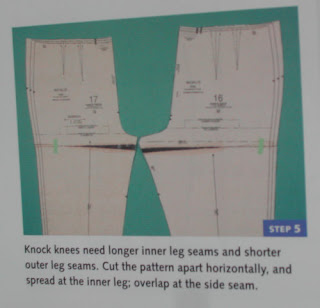Let's see … where was I? Oh yes. I had just finished tucking up a good amount of length between crotch and knee on the Burda WOF pants muslin.
I've now made that alteration to my pattern pieces and have cut the good fabric. As I mentioned on Sunday, I knew that my extended calves were playing a part in this fitting conundrum. As I was slicing and dicing my pattern pieces, this was confirmed. What that crotch-to-knee tuck actually did was to bring up a wider section of the pants leg to calf level. So, it's not really the length that was the culprit; it was a matter of putting the required width at the proper level. Well, in theory at the moment, because I'm still sewing the pants.
Sunday night, I went to bed with some of my fitting books to re-read any info on alterations for full inner thighs and/or knock knees (FiT/KK).
(Both body types display the same rear X wrinkles.) In my pile were:
Fitting Finesse (Zieman)
Fantastic Fit for Every Body (Grigg Hazen)
Fast Fit (Betzina)
Sewing Pants That Fit (Singer Reference Library)
The Perfect Fit (Singer Reference Library)
Pants and Skirts Fit for Your Shape (Minott)
Fitting Finesse had nothing. Zero. There is some basic info for full thighs, but nothing specific for full *inner* thighs or KK
(or bowed legs, which is the direct fitting opposite of KK).Fantastic Fit for Every Body was another miss. It usually is. I really don't know why I hang on to this book. I've never once used anything from it and some of the advice is just plain wrong, IMO. But I digress.
Fast Fit does address the FiT/KK issue:
(Click on all the photos for bigger, clear versions.)With the Fast Fit method for KK, I would still have to add width between crotch and knee because my issue is actually FiT, not KK. FiTs still need more width than what you get with this alteration alone. There is another section in this book which illustrates how to achieve that extra width by adding to the inseams, with the length of the addition dependent on how full the thighs are. After that, I would still have to re-establish a vertical grainline, because as you should be able to see, the alteration below angles the original grain outward.

I know the Fast Fit method works, as it's the basis for my previous X-wrinkles alteration,
here. But I'm fickle, and curious, so I wanted to try something different. ;-)
An Anonymous commenter mentioned that I should buy the Singer books instead of the "expensive" Minott books because the Minott info is also in the Singer books. Well, first, I already have both Singer and Minott so acquisition/price isn't an issue. But, the main point of my response to this comment is that while the FiT/KK Singer alteration starts like Minott, the end result is different.
Both methods start out by slashing the pattern at the knee and sliding the knee-to-ankle section toward the inseam, as in this section from Minott:


In Sewing Pants That Fit, you are never instructed how to true the seamlines after the slash/slide
(oops). In The Perfect Fit, this is the illustration and instructional text for truing the seamlines to finish the adjustment:

It's an at-first-glance subtle difference between Singer and Minott, but upon further inspection the difference is really quite significant. With the Minott method, the entire leg is shifted toward the center of the body, with the overall width of the pant leg remaining virtually unchanged. This is what I want, pants that have the same cut as the original pattern but which have been adjusted to follow the shape/slant of my leg.
The Singer method starts out OK, but the way you are instructed to true up the outseam gaps left after sliding the lower section toward the middle gives you pants that are still centered on the "perfect" leg exactly as before but now they're also wider.
Minott trues the outseam from the bottom up. Singer trues from the top down. It makes a difference.
So now I'm going to go back to the sewing room and work on finishing those pants to see if my thinking works in practice as well as theory.




























































